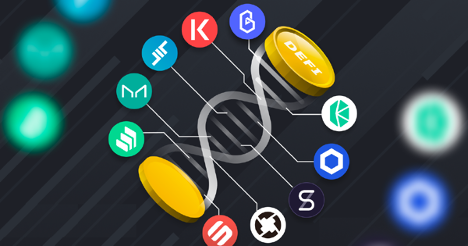Decentralized Finance (DeFi) is a budding monetary infrastructure that is capable of eliminating the need for third-party intermediaries, for example, government bodies, to approve ongoing transactions. Instead of this, DeFi is based on the immutable and decentralized ledger known as the blockchain, the same technology on which the world’s first cryptocurrency, “Bitcoin,” is based.
This technology makes way for peer-to-peer transactions, thereby allowing the users to interact directly and in a safe manner without any need for a third-party intermediary. As a result, DeFi is capable of offering users greater autonomy and control over their day-to-day financial activities, as well as increased security and privacy.
Blockchain technology has enabled decentralized finance (DeFi) to work on a network of computers, rather than a single server, in a similar manner to modern-day financial applications. This revolutionary development in the financial sector will not only enable peer-to-peer payments but also revolutionize the process of borrowing and lending, as well as a host of other financial activities.
By leveraging the power of blockchain technology, DeFi has the potential to revolutionize everything related to managing finances.
This article will help you understand the process of creating a robust DeFi mobile app. Since the DeFi app market was valued at $13.61 billion in 2022 and is expected to witness a CAGR of 46.0% from 2023 to 2030, now is the right time to invest in a dedicated mobile app development company in the USA that can help you traverse the market and create a robust app, capable of gaining instant traction.
Let us now move ahead and look at the decentralized exchange app development process in detail.
How to build a DeFi mobile app?
- Installing the Truffle Platform
Before the development of DeFi applications, installing the Truffle platform is essential. It is a development platform for testing the frameworks and pipelines associated with Ethereum. This platform allows for the integration of multiple smart contracts and their deployment to a specific network. After deployment, these contracts are tested by the quality assurance engineers for functionality, and their interface, which features the deployed contracts, is made easy to use. The command-line interface is also beneficial for the deployment of contracts.
- Creating an ERC20 Token
The next step in the decentralized exchange app development process is creating an ERC20 Token, which is one of the effective ways to develop concepts that are related to smart contracts and the Ethereum Blockchain. It is a commonly used token for launching ICOs and is usually hosted on the Ethereum Blockchain. The ERC20 token describes an interface standard for the Ethereum Blockchain, allowing developers to understand the functionalities of new tokens in a better way.
- Work on the creation of smart contracts
Smart contracts are computer codes that are self-executing and are capable of autonomously enforcing the terms of an agreement between multiple parties. Once the transaction conditions are met, the code is executed, which further enforces the rules and regulations that have been pre-defined. The use of smart contracts allows developers to create decentralized applications (dApps) that are highly secure and efficient, allowing for smooth performance and easy transactions.
- UI/UX design
It is essential to pay close attention to the UI/UX design while building a Defi mobile app. UI/UX design of the app impacts the first impression that users will have of the Defi application, and thus, it is vital to ensure that the design of the app is visually appealing and uncluttered. This will ensure a smooth user experience, which will make way for a higher customer retention rate. It is important to keep these things in mind while developing a Defi project.
- Set up the front end and back end
DeFi users can interact with the front-end applications, which are further connected to the backend APIs. This connection makes it possible to create an attractive user interface and offer a seamless user experience, further offering the users access to multiple functionalities of a DeFi app. On the other hand, backend integration is used to integrate both the backend and front-end applications into the blockchain, allowing for a secure experience.
- Rigorous testing
It is imperative that DeFi applications are tested rigorously before launching them. To ensure the seamless functionality of the smart contracts, it is further vital to review the codes. This can be achieved by using a testnet. It is vital to remember that once you deploy a defective smart contract on the internet, it cannot be altered afterward.
- Deployment and Maintenance
Deployment of a DeFi app is the final stage in the app development process which makes it available to users on the App Store and Google Play. However, maintenance is an ongoing process, and the app would require regular updates to ensure that it is functioning optimally.
The development of DeFi applications requires a deep understanding of Blockchain technology, as well as a comprehensive knowledge of the financial ecosystem. Thus, many start-ups are now turning to professional service providers to ensure their DeFi applications meet the highest standard. By leveraging the rapidly advancing DeFi ecosystem, businesses are now capable of benefiting from a dedicated app development company to create the best possible app as per their custom needs. Now is the right time to take advantage of this revolutionary and evolving technology and reap the rewards.


